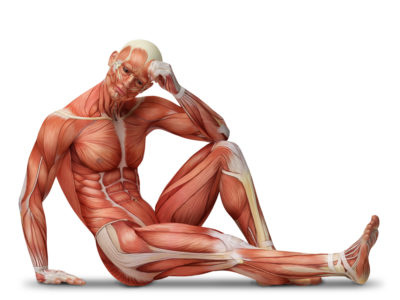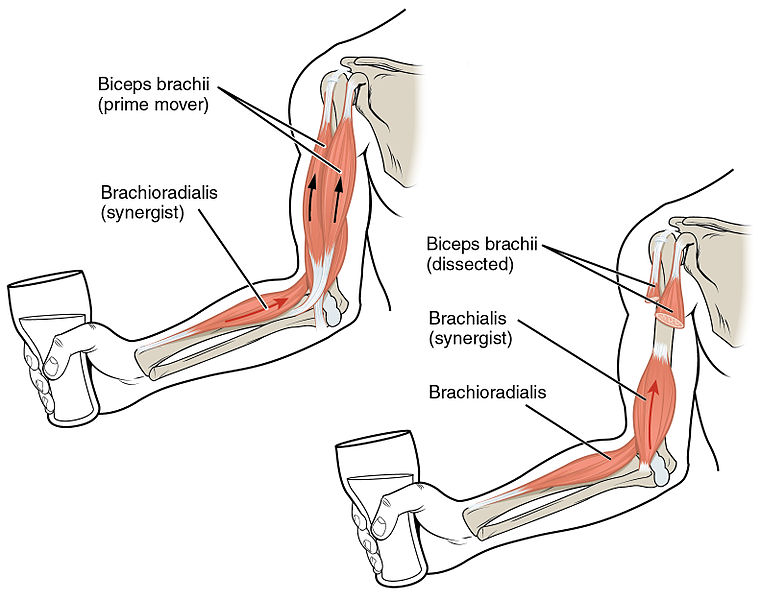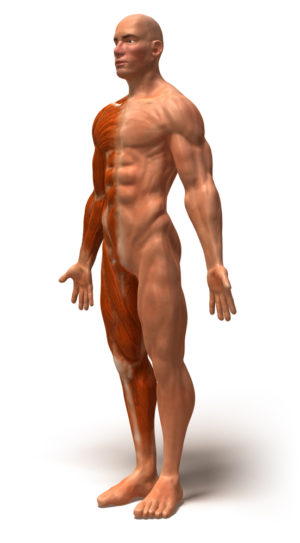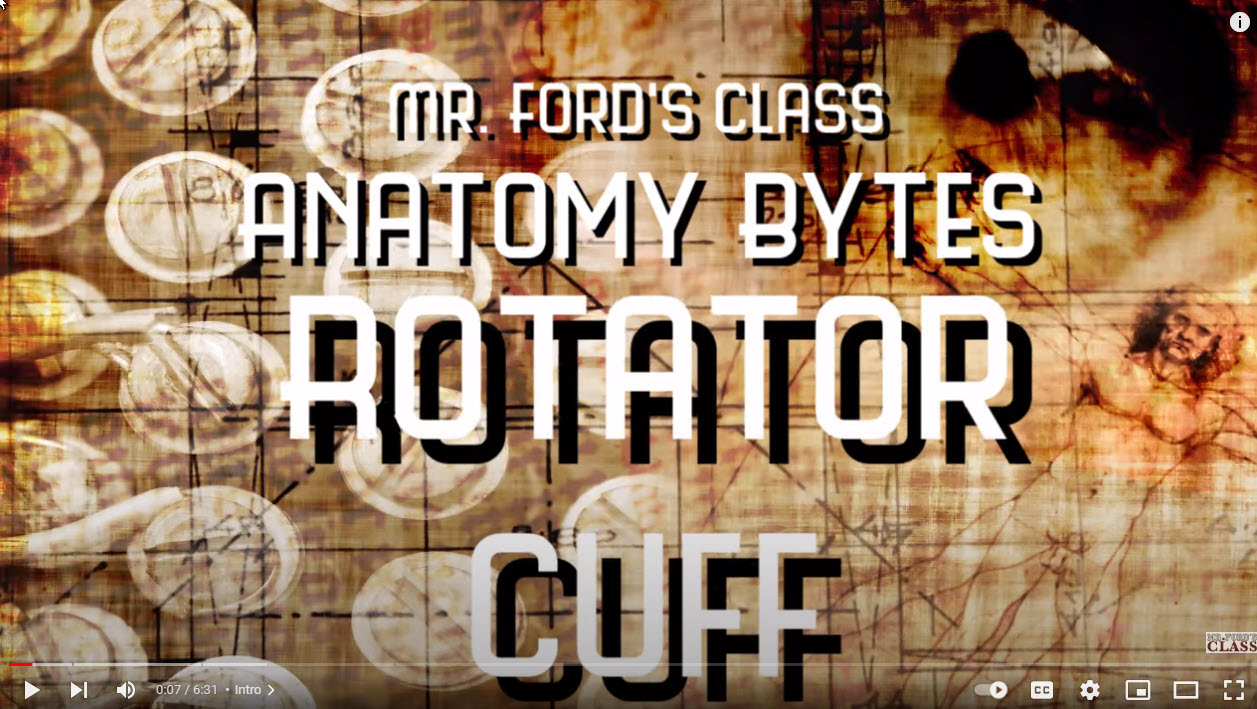Making sense of muscle names
Human body muscles are divided into groups named for the gross movement they cause at bone joints. Human muscle groups are named by the direction in which they position, or move about, the bones of the human skeleton. Muscle group names, by design, represent clear opposite directions because of how human joints are engineered.
An individual muscle within a group may, or may not, carry the name of the group as part of its full name. Some muscles are named to match the name of the bone to which it attaches. Other muscles are named with a word that describes its shape.
The complex arrangement of bone attachments for individual human muscles permits a wide range of controlled elegant movement of the human skeleton. Bone attachment patterns compensate for the fact that muscles work in a straight line. Each individual muscle has a narrow range of motion because it can do no more than shorten and lengthen.
Muscle name reflects its control of motion.
Flexor muscles vs. extensor muscles
In human anatomy all descriptions of body motion are based upon the assumption that the starting place is the body in the anatomical position. Review the picture of the male figure in the anatomical position and notice the position of his hands, arms, legs, and head.
Flexor muscle groups cause bending movement that decreases the angle between two body parts – starting from the anatomical position. Bending at the elbow, clenching a hand into a fist, and sitting down are movements achieved by contraction, shortening of the flexor muscles. The movement itself is called flexion, and the word ‘flexor’ will sometimes be found as part of the name of an individual muscle in one of these groups.
The opposite movement is extension. Extensor muscles cause movement that increases the angle between body parts. To stand up from a sitting position the knee joints must be ‘extended’ – the angle between the leg and thigh increasing in size. Muscles that move the leg or arm posterior to the anatomical position also fall into the class called extensors. Muscles that cause extension often contain the term ‘extensor’ as part of their name.
Abductors and adductors
Another set of descriptive terms, abduction and adduction, were devised to group muscles that pull body structures away from, or toward, the midline of the body, or the midline of the hand, or the midline of the foot. Raising the arms laterally is an example of abduction. Dropping the arms back to the sides of the body is an example of adduction. Again, some of the muscles, but not all, responsible for such movement will include in their full name the word ‘abductor’ or ‘adductor’.

Which muscle actions, flexion, extension, abduction, adduction are displayed? Julian Tromeur/Shutterstock.com
Rotators
Rotational motion at the shoulder, and hip joint may be toward the median of the body, medial rotation, or away from the median of the body, lateral rotation. Click this link for a 3-minute video that demonstrates anatomical motions that you will want to remember before you begin to learn names of muscles.
As discussed in another article on this website, Orientation in Anatomy, it is important not to blow off learning these simple opposite terms describing human body movement. This is because one of the 3 major characteristics of each human muscle you will need to learn will be the action taken by that muscle – flexion, extension, rotation, abduction, etc.
The other 2 characteristics you will need to know are each muscle’s major points of attachment to its bone – the origin (end of the bone that does not move much when the muscle shortens) and the insertion (end of the bone that moves a lot when the muscle shortens). More about why origins and insertions of muscles are important to understanding muscle anatomy and physiology can be found in another article Muscle Origins Insertions and Levers.
This video by the famous Mr. Ford uses these anatomic terms as he walks you through the muscles of the most complex joint arrangement in the human body, the rotator cuff muscle group that control full rotation of the arm.
Two other videos you may find helpful as you study muscle names are Muscle Names Have Meaning and Best Ways to Study the Muscular System. Check it out by clicking on the title.
Further reading
Repetition in Anatomical Names
Do you have questions?
I would enjoy hearing from you. Please put your questions in the comment box or send them to me by email at DrReece@MedicalScienceNavigator.com. I read and reply to all comments and email.
If you find this article helpful share it with your fellow students or send it to your favorite social media site by clicking on one of the buttons on this article.
 Margaret Thompson Reece PhD, physiologist, former Senior Scientist and Laboratory Director at academic medical centers in California, New York and Massachusetts is now Manager at Reece Biomedical Consulting LLC.
Margaret Thompson Reece PhD, physiologist, former Senior Scientist and Laboratory Director at academic medical centers in California, New York and Massachusetts is now Manager at Reece Biomedical Consulting LLC.
She taught physiology for over 30 years to undergraduate and graduate students, at two- and four-year colleges, in the classroom and in the research laboratory. Her books “Physiology: Custom-Designed Chemistry”, “Inside the Closed World of the Brain”, and her online course “30-Day Challenge: Craft Your Plan for Learning Physiology”, and “Busy Student’s Anatomy & Physiology Study Journal” are created for those planning a career in healthcare. More about her books is available at https://www.amazon.com/author/margaretreece. You may contact Dr. Reece at DrReece@MedicalScienceNavigator.com, or on LinkedIn
Dr. Reece offers a free 30 minute “how-to-get-started” phone conference to students struggling with human anatomy and physiology. Schedule an appointment by email at DrReece@MedicalScienceNavigator.com.




Great article over again! Thank you!
Thanks for any other excellent post. The place else may anybody get that type of information in such a perfect
way of writing? I’ve a presentation next week, and I’m at the look for such information.
You’re so interesting! I don’t suppose I have read through
something like that before. So nice to discover somebody with a few unique thoughts on this issue.
Really.. thanks for starting this up. This website is one thing that’s needed on the web, someone with a bit of originality!
Thank you for your kind words.
Pingback:10 Amazing Facts About Human Body That’ll Make You Say “Wow!” - The Life Of Facts
Pingback:human anatomy muscle references – Jihyo's Artworks